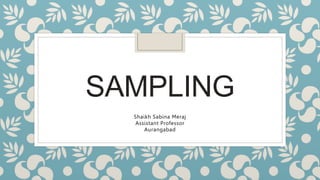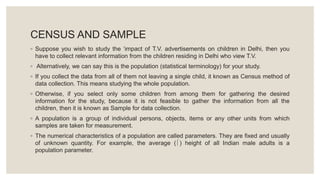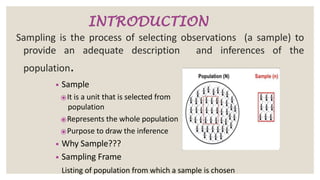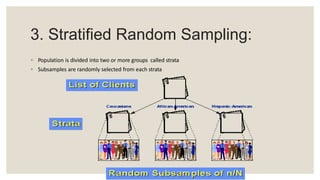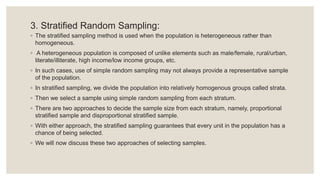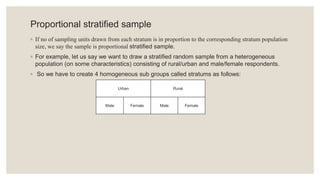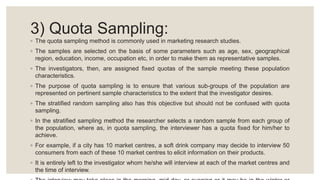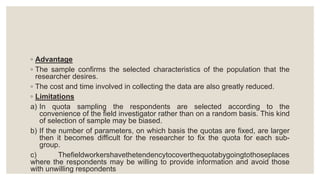biostatistics and research methodology, Sampling
- 1. SAMPLING Shaikh Sabina Meraj Assistant Professor Aurangabad
- 2. CENSUS AND SAMPLE ◦ Suppose you wish to study the ‘impact of T.V. advertisements on children in Delhi, then you have to collect relevant information from the children residing in Delhi who view T.V. ◦ Alternatively, we can say this is the population (statistical terminology) for your study. ◦ If you collect the data from all of them not leaving a single child, it known as Census method of data collection. This means studying the whole population. ◦ Otherwise, if you select only some children from among them for gathering the desired information for the study, because it is not feasible to gather the information from all the children, then it is known as Sample for data collection. ◦ A population is a group of individual persons, objects, items or any other units from which samples are taken for measurement. ◦ The numerical characteristics of a population are called parameters. They are fixed and usually of unknown quantity. For example, the average () height of all Indian male adults is a population parameter.
- 3. The following are the advantages of census: 1. In a census each and every respondent of the population is considered and various population parameters are compiled for information. 2.The information obtained on the basis of census data is more reliable and accurate. It is an adopted method of collecting data on exceptional matters like child labour, distribution by sex, educational level of the people etc. 3.If we are conducting a survey for the first time we can have a census instead of sample survey. The information based on this census method becomes a base for future studies. Similarly, some of the studies of special importance like population data are obtained only through census.
- 4. Sampling is the process of selecting observations (a sample) to provide an adequate description and inferences of the population. ◾ Sample ⦿It is a unit that is selected from population ⦿Represents the whole population ⦿Purpose to draw the inference ◾ Why Sample??? ◾ Sampling Frame Listing of population from which a sample is chosen
- 5. Population Sample Sampling Frame Sampling Process What you want to talk about What you actually observe in the data Inference
- 8. ◦ One of the decisions to be made by a researcher in conducting a survey is whether to go for a census or a sample survey. We obtain a sample rather than a complete enumeration (a census ) of the population for many reasons. 1. Cost: The cost of conducting surveys through census method would be prohibitive and sampling helps in substantial cost reduction of surveys. Since most often the financial resources available to conduct a survey are scarce, it is imperative to go for a sample survey than census. 2.Size of the Population: If the size of the population is very large it is difficult to conduct a census if not impossible. In such situations sample survey is the only way to analyse the characteristics of a population. 3. Accuracy of Data: Although reliable information can be obtained through census, sometime the accuracy of information may be lost because of a large population. Sampling involves a small part of the population and a few trained people can be involved to collect accurate data. On the other hand, a lot of people are required to enumerate all the observations. Often it becomes difficult to involve trained manpower in large numbers to collect the data thereby compromising accuracy of data collected. In such a situation a sample may be more accurate than a census. A sloppily conducted census can provide less reliable information than a carefully obtained sample.
- 9. 4. Accessibility of Population: There are some populations that are so difficult to get access to that only a sample can be used, e.g., people in prison, birds migrating from one place to another place etc. The inaccessibility may be economic or time related. In a particular study, population may be so costly to reach, like the population of planets, that only a sample can be used. 5. Timeliness: Since we are covering a small portion of a large population through sampling, it is possible to collect the data in far less time than covering the entire population. Not only does it take less time to collect the data through sampling but the data processing and analysis also takes less time because fewer observations need to be covered. Suppose a company wants to get a quick feedback from its consumers on assessing their perceptions about a new improved detergent in comparison to an existing version of the detergent. Here the time factor is very significant. In such situations it is better to go for a sample survey rather than census because it reduces a lot of time and product launch decision can be taken quickly. 6. Destructive Observations: Sometimes the very act of observing the desired characteristics of a unit of the population destroys it for the intended use. Good examples of this occur in quality control. For example, to test the quality of a bulb, to determine whether it is defective, it must be destroyed. To obtain a census of the quality of a lorry load of bulbs, you have to destroy all of them. This is contrary to the purpose served by quality-control testing.
- 10. The disadvantages of sampling 1.Risk: Using a sample from a population and drawing inferences about the entire population involves risk. In other words the risk results from dealing with a part of a population. If the risk is not acceptable in seeking a solution to a problem then a census must be conducted. 2.Lack of representativeness: Determining the representativeness of the sample is the researcher’s greatest problem. By definition, ‘sample’means a representative part of an entire population. It is necessary to obtain a sample that meets the requirement of representativeness otherwise the sample will be biased. The inferences drawn from nonreprentative samples will be misleading and potentially dangerous. 3.Insufficient sample size: The other significant problem in sampling is to determine the size of the sample. The size of the sample for a valid sample depends on several factors such as extent of risk that the researcher is willing to accept and the characteristics of the population itself.
- 11. ESSENTIALS OF A GOOD SAMPLE 1.A sample must represent a true picture of the population from which it is drawn. 2.A sample must be unbiased by the sampling procedure. 3. A sample must be taken at random so that every member of the population of data has an equal chance of selection. 4.A sample must be sufficiently large but as economical as possible. 5. A sample must be accurate and complete. It should not leave any information incomplete and should include all the respondents, units or items included in the sample. 6.Adequate sample size must be taken considering the degree of precision required in the results of inquiry.
- 12. METHODS OF SAMPLING ◦ Random Sampling Methods ◦ The random sampling method is also often called probability sampling. ◦ In random sampling all units or items in the population have a chance of being chosen in the sample. ◦ In other words a random sample is a sample in which each element of the population has a known and non-zero chance of being selected. ◦ Random sampling always produces the smallest possible sampling error. ◦ In the real sense, the size of the sampling error in a random sample is affected only by a random chance. ◦ Because a random sample contains the least amount of sampling error, we may say that it is an unbiased sample. ◦ The following are the important methods of random sampling: 1) Simple Random Sampling 2) Systematic Sampling 3) Stratified Random Sampling 4) Cluster Sampling
- 13. 1. Simple Random Sampling:
- 14. 1. Simple Random Sampling: ◦ The most commonly used random sampling method is simple random sampling method. ◦ A simple random sample is one in which each item in the total population has an equal chance of being included in the sample. ◦ In addition, the selection of one item for inclusion in the sample should in no way influence the selection of another item. ◦ Simple random sampling should be used with a homogeneous population, that is, a population consisting of items that possess the same attributes that the researcher is interested in. ◦ The characteristics of homogeneity may include such as age, sex, income, social/religious/political affiliation, geographical region etc. ◦ A random sampling method should meet the following criteria. 1.Every member of the population must have an equal chance of inclusion in the sample. 2.The selection of one member is not affected by the selection of previous members.
- 15. ◦ Advantages 1. The simple random sample requires less knowledge about the characteristics of the population. 2. Since sample is selected at random giving each member of the population equal chance of being selected the sample can be called as unbiased sample. Bias due to human preferences and influences is eliminated. 3.Assessment of the accuracy of the results is possible by sample error estimation. 4.It is a simple and practical sampling method provided population size is not large. ◦ Limitations 1.If the population size is large, a great deal of time must be spent listing and numbering the members of the population. 2.A simple random sample will not adequately represent many population characteristics unless the sample is very large. That is, if the researcher is interested in choosing a sample on the basis of the distribution in the population of gender, age, social status, a simple random sample needs to be very large to ensure all these distributions are representative of the
- 17. 2. Systematic Sampling: ◦ In systematic sampling the sample units are selected from the population at equal intervals in terms of time, space or order. The selection of a sample using systematic sampling method is very simple. From a population of ‘N’ units, a sample of ‘n’ units may be selected by following the steps given below: 1.Arrange all the units in the population in an order by giving serial numbers from1toN. 2.Determine the sampling interval by dividing the population by the sample size. That is, K=N/n. 3.Select the first sample unit at random from the first sampling interval (1 to K). 4. Select the sub sequent sample units at equal regular intervals.
- 18. ◦ Advantages 1.The main advantage of using systematic sample is that it is more expeditious to collect a sample systematically since the time taken and work involved is less than in simple random sampling. For example, it is frequently used in exit polls and store consumers. 2.This method can be used even when no formal list of the population units is available. For example, suppose if we are interested in knowing the opinion of consumers on improving the services offered by a store we may simply choose every kth (say 6th) consumer visiting a store provided that we know how many consumers are visiting the store daily (say 1000 consumers visit and we want to have 100 consumers as sample size). ◦ Limitations 1.If there is periodicity in the occurrence of elements of a population, the selection of sample using systematic sample could give a highly un-representative sample. For example, suppose the sales of a consumer store are arranged chronologically and using systematic sampling we select sample for 1st of every month. The 1st day of a month can not be a representative sample for the whole month. Thus in systematic sampling there is a danger of order bias. 2. Every unit of the population does not have an equal chance of being selected and the
- 19. 3. Stratified Random Sampling: ◦ Population is divided into two or more groups called strata ◦ Subsamples are randomly selected from each strata
- 20. 3. Stratified Random Sampling: ◦ The stratified sampling method is used when the population is heterogeneous rather than homogeneous. ◦ A heterogeneous population is composed of unlike elements such as male/female, rural/urban, literate/illiterate, high income/low income groups, etc. ◦ In such cases, use of simple random sampling may not always provide a representative sample of the population. ◦ In stratified sampling, we divide the population into relatively homogenous groups called strata. ◦ Then we select a sample using simple random sampling from each stratum. ◦ There are two approaches to decide the sample size from each stratum, namely, proportional stratified sample and disproportional stratified sample. ◦ With either approach, the stratified sampling guarantees that every unit in the population has a chance of being selected. ◦ We will now discuss these two approaches of selecting samples.
- 21. Proportional stratified sample ◦ If no of sampling units drawn from each stratum is in proportion to the corresponding stratum population size, we say the sample is proportional stratified sample. ◦ For example, let us say we want to draw a stratified random sample from a heterogeneous population (on some characteristics) consisting of rural/urban and male/female respondents. ◦ So we have to create 4 homogeneous sub groups called stratums as follows: Urban Rural Male Female Male Female
- 22. Disproportional Stratified Sample: ◦ In a disproportional stratified sample, sample size for each stratum is not allocated on a proportional basis with the population size, but by analytical considerations of the researcher such as stratum variance, stratum population, time and financial constraints etc. ◦ For example, if the researcher is interested in finding differences among different stratums, disproportional sampling should be used. ◦ Consider the example of income distribution of households. ◦ There is a small percentage of households within the high income brackets and a large percentage of households within the low income brackets. ◦ The income among higher income group households has higher variance than the variance among the lower income group house- holds. ◦ To avoid under-representation of higher income groups in the sample, a disproportional sample is taken. ◦ This indicates that as the variability within the stratum increases sample size must increase to provide accurate estimates and vice-versa.
- 23. ◦ Advantages a) Since the sample are drawn from each of the stratums of the population, stratified sampling is more representative and thus more accurately reflects characteristics of the population from which they are chosen. b) It is more precise and to a great extent avoids bias. c) Since sample size can be less in this method, it saves a lot of time, money and other resources for data collection. ◦ Limitations a) Stratified sampling requires a detailed knowledge of the distribution of attributes or characteristics of interest in the population to determine the homogeneous groups that lie within it. If we cannot accurately identify the homogeneous groups, it is better to use simple random sample since improper stratification can lead to serious errors. b) Preparing a stratified list is a difficult task as the lists may not be readily available.
- 24. 4. Cluster Sampling ◦ The population is divided into subgroups (clusters) like families. ◦ A simple random sample is taken from each cluster.
- 25. 4. Cluster Sampling ◦ In cluster sampling we divide the population into groups having heterogenous characteristics called clusters and then select a sample of clusters using simple random sampling. ◦ We assume that each of the clusters is representative of the population as a whole. This sampling is widely used for geographical studies of many issues. ◦ For example if we are interested in finding the consumers’ (residing in Delhi) attitudes towards a new product of a company, the whole city of Delhi can be divided into 20 blocks. ◦ We assume that each of these blocks will represent the attitudes of consumers of Delhi as a whole, we might use cluster sampling treating each block as a cluster. ◦ We will then select a sample of 2 or 3 clusters and obtain the information from consumers covering all of them. ◦ The principles that are basic to the cluster sampling are as follows: 1.The differences or variability within a cluster should be as large as possible. As far as possible the variability within each cluster should be the same as that of the population. 2.The variability between clusters should be as small as possible. Once the clusters are selected, all the units in the selected clusters are covered for obtaining data.
- 26. ◦ Advantages 1.The cluster sampling provides significant gains in data collection costs, since traveling costs are smaller. 2.Since the researcher need not cover all the custers and only a sample of clusters are covered, it becomes a more practical method which facilitates fieldwork. ◦ Limitations 1.The cluster sampling method is less precise than sampling of units from the whole population since the latter is expected to provide a better cross-section of the population than the former, due to the usual tendency of units in a cluster to be homogeneous. 2.The sampling efficiency of cluster sampling is likely to decrease with the decrease in cluster size or increase in number of clusters.
- 27. 5. Multistage Sampling: ◦ Carried out in stages ◦ Using smaller and smaller sampling units at each stage 1 2 3 4 5 6 7 8 9 1 0 1 2 3 4 5 6 7 8 9 1 0 1 1 1 2 1 3 1 4 1 5 S e c o n d a r y C l u s t e r s S i m p l e R a n d o m S a m p l i n g w i t h i n
- 28. 5. Multistage Sampling: ◦ We have already covered two stage sampling. Multi stage sampling is a generalisation of two stage sampling. ◦ As the name suggests, multi stage sampling is carried out in different stages. ◦ In each stage progressively smaller (population) geographic areas will be randomly selected. ◦ A political pollster interested in assembly elections in Uttar Pradesh may first divide the state into different assembly units and a sample of assembly constituencies may be selected in the first stage. ◦ In the second stage, each of the sampled assembly constituents are divided into a number of segments and a second stage sampled assembly segments may be selected. ◦ In the third stage within each sampled assembly segment either all the house-holds or a sample random of households would be interviewed. ◦ In this sampling method, it is possible to take as many stages as are necessary to achieve a representative sample. ◦ Each stage results in a reduction of sample size.
- 29. ◦ Advantages 1.Multistage sampling provides cost gains by reducing the data collection on costs. 2.Multistage sampling is more flexible and allows us to use different sampling procedures in different stages of sampling. 3.If the population is spread over a very wide geographical area, multistage sampling is the only sampling method available in a number of practical situations. ◦Limitations ◦a) If the sampling units selected at different stages are not representative multistage sampling becomes less precise and efficient.
- 30. Non-Random Sampling Methods ◦ The non-random sampling methods are also often called non-probability sampling methods. ◦ In a non-random sampling method the probability of any particular unit of the population being chosen is unknown. ◦ Here the method of selection of sampling units is quite arbitrary as the researchers rely heavily on personal judgment. ◦ Non-random sampling methods usually do not produce samples that are representative of the general population from which they are drawn. ◦ The greatest error occurs when the researcher attempts to generalise the results on the basis of a sample to the entire population. ◦ The various non-random sampling methods commonly used are: 1) Convenience Sampling; 2) Judgement Sampling 3) Quota Sampling.
- 31. 1) Convenience Sampling: ◦ Convenience sampling refers to the method of obtaining a sample that is most conveniently available to the researcher. ◦ For example, if we are interested in finding the overtime wage paid to employees working in call centres, it may be convenient and economical to sample employees of call centres in a near by area. ◦ Also, on various issues of public interest like budget, election, price rise etc., the television channels often present on-the-street interviews with people to reflect public opinion. ◦ It may be cautioned that the generalisation of results based on convenience sampling beyond that particular sample may not be appropriate. Convenience samples are best used for exploratory research when additional research will be subsequently conducted with a random sample. Convenience sampling is also useful in testing the questionnaires designed on a pilot basis. Convenience sampling is extensively used in marketing studies.
- 32. 2) Judgement Sampling: ◦ Judgement sampling method is also known as purposive sampling. ◦ In this method of sampling the selection of sample is based on the researcher’s judgment about some appropriate characteristic required of the sample units. ◦ For example, the calculation of consumer price index is based on a judgment sample of a basket of consumer items, and other related commodities and services which are expected to reflect a representative sample of items consumed by the people. ◦ The prices of these items are collected from selected cities which are viewed as typical cities with demographic profiles matching the national profile. ◦ In business judgment sampling is often used to measure the performance of salesmen/saleswomen. ◦ The salesmen/saleswomen are grouped into high, medium or low performers based on certain specified qualities. ◦ Then the sales manager may actually classify the salesmen/saleswomen working under him/her who in his/her opinion will fall in which group. ◦ Judgment sampling is also often used in forecasting election results. ◦ We may often wonder how a pollster can predict an election based on only 2% to 3% of votes covered. ◦ It is needless to say the method is biased and does not have any scientific basis.
- 33. 3) Quota Sampling: ◦ The quota sampling method is commonly used in marketing research studies. ◦ The samples are selected on the basis of some parameters such as age, sex, geographical region, education, income, occupation etc, in order to make them as representative samples. ◦ The investigators, then, are assigned fixed quotas of the sample meeting these population characteristics. ◦ The purpose of quota sampling is to ensure that various sub-groups of the population are represented on pertinent sample characteristics to the extent that the investigator desires. ◦ The stratified random sampling also has this objective but should not be confused with quota sampling. ◦ In the stratified sampling method the researcher selects a random sample from each group of the population, where as, in quota sampling, the interviewer has a quota fixed for him/her to achieve. ◦ For example, if a city has 10 market centres, a soft drink company may decide to interview 50 consumers from each of these 10 market centres to elicit information on their products. ◦ It is entirely left to the investigator whom he/she will interview at each of the market centres and the time of interview.
- 34. ◦ Advantage ◦ The sample confirms the selected characteristics of the population that the researcher desires. ◦ The cost and time involved in collecting the data are also greatly reduced. ◦ Limitations a) In quota sampling the respondents are selected according to the convenience of the field investigator rather than on a random basis. This kind of selection of sample may be biased. b) If the number of parameters, on which basis the quotas are fixed, are larger then it becomes difficult for the researcher to fix the quota for each sub- group. c) Thefieldworkershavethetendencytocoverthequotabygoingtothoseplaces where the respondents may be willing to provide information and avoid those with unwilling respondents
- 35. ⦿The errors which arise due to the use of sampling surveys are known as the sampling errors. Two types of sampling errors ⦿Biased Errors- Due to selection of sampling techniques; size of the sample. ⦿Unbiased Errors / Random sampling errors- Differences between the members of the population included or not included.
- 36. ⦿Specific problem selection. ⦿Systematic documentation of related research. ⦿Effective enumeration. ⦿Effective pre testing. ⦿Controlling methodological bias. ⦿Selection of appropriate sampling techniques.
- 37. ⦿ Non-sampling errors refers to biases and mistakes in selection of sample. ⦿CAUSES FOR NON-SAMPLING ERRORS Sampling operations Inadequate of response Misunderstanding the concept Lack of knowledge Concealment of the truth. Loaded questions Processing errors Sample size
- 38. Thank You
